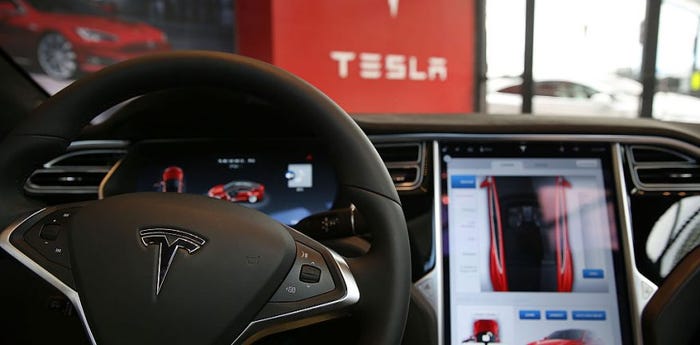2020 Predictions: Computer Vision Projects Will Gain Ground
Computer vision projects are gaining momentum, laying the foundation for an uptick in adoption in 2020.
January 6, 2020

While various forms of artificial intelligence have gained ground in the past couple of years, one form of it—computer vision—shows particular promise in 2020.
Already in 2020, an artificial intelligence (AI) system beat human experts in detecting breast cancer in a recent study published in the journal Nature. The researchers involved in the project, which included Google employees and U.S. and U.K. medical experts, pushed computer vision advances even further. Computer vision applications on the market can do everything from scanning radiological images to determining the contents of a refrigerator.
The variety of computer vision projects could expand in 2020. “Computer vision will be the killer app for AI at the edge,” said Jason Shepherd, vice president of ecosystem at Zededa.
As he speculated on the key trends at this year’s Consumer Electronics Show (CES), Thomas Husson, vice president and principal analyst at Forrester, was upbeat about computer vision. At CES, Husson expects a growing focus on computer vision as well as on augmented reality and advanced audio technologies.
While enterprises have adopted computer vision at a faster rate than consumers, computer vision is heating up in the consumer space as well. The public has become more exposed to the technology given that a facial recognition feature can now unlock smartphones., And consumer websites such as Pinterest have helped popularize visual search. “Detecting objects in context will also open up new use cases when paired with other technologies such as augmented reality or IoT,” Husson said.
[IoT World is North America’s largest IoT event where strategists, technologists and implementers connect, putting IoT, AI, 5G and edge into action across industry verticals. Book your ticket now.]
IP camera proliferation is also boosting computer vision projects. An IHS Markit report predicted some 1 billion surveillance cameras by 2021. In addition, cameras are increasingly deployed in the industrial sector, in autonomous vehicles, drones, augmented reality and beyond. And cameras are “one of the best sensors around for deriving rich, high-bandwidth information,” according to Shepherd.
Computer vision remains a popular topic for researchers at tech firms and academia. Tech heavyweights such as IBM, Amazon, the Chinese firms Baidu and Tencent, Microsoft and Google all have substantial computer vision initiatives, as do many prominent international academic institutions.
Analyst firms are also optimistic about computer vision’s prospects. Computer vision was one of the most mature technologies in the Gartner Hype Cycle for Artificial Intelligence, 2019. Gartner projected the AI subsector to be between two and five years away from mainstream adoption, while the most-recent Forrester New Wave dedicated to computer vision platforms counted 11 vendors. The Forrester document also concluded that the computer vision platform market was moving at “light speed.”
Computer vision projects are admittedly overhyped but also promise superhuman results. In law enforcement, for instance, surveillance cameras equipped with computer vision could theoretically find a wanted fugitive in a crowd of hundreds.
And the technique could potentially be used to help address a shortage of radiologists in countries such as the U.S. and the U.K.
Ankur Tomar, regional solutions marketing manager at Newark, also notes that computer vision techniques can improve the localization of robots and inspection systems in industrial settings. If computer vision is used in tandem with sensor fusion, Tomar foresees the technique having an array of potential applications.
“In industrial computer vision applications,” Tomar said, “a quality-control inspector […] can use data from multiple sensors recorded during assembly in addition to pictures of an assembled product, to assess whether it should pass or fail.”
While computer vision adoption is expanding, it’s still early days. A universal challenge for computer vision is data overload. Few organizations are well equipped to process massive amounts of image or video data in an automated fashion.
Another barrier to widespread computer vision adoption — at least for surveillance applications — is the privacy ramifications. “In addition to consuming high bandwidth and leveraging different tool sets than edge computing workloads that involve structured/binary data, computer vision workloads are unique in that they tend to raise the most concerns about privacy,” said Shepherd, of Zededa.
Computers have improved at sensing the surrounding world around us, “hence the massive data and privacy implications,” agreed Husson.
The privacy concerns relating to facial recognition have received widespread attention. In 2019, San Francisco and Oakland, California, and a trio of Massachusetts communities banned facial recognition tools for use in law enforcement. Portland, Oregon, plans to do the same.
Meanwhile, a growing number of governments have prioritized privacy-related legislation — with the General Data Protection Regulation and the California Consumer Privacy Act being two prominent examples.
The growing interest in computer vision for surveillance, among other things, will lead to a “focus on ensuring that PII [personally identifiable information] is handled appropriately, with details being removed at the point of data creation based on policy,” Shepherd said.
Athena Security, an Austin, Texas–based startup that makes a gun-detecting security camera system, is using such an approach. The system blurs subjects’ faces and does not use cloud-based storage Lisa Falzone, chief executive officer at Athena Security, said the approach could help prevent or speed the response to mass shootings without infringing on the public’s privacy.
Shepherd predicts there will be an uptick in the sharing of data sets that support the public good. He sees this trend especially relevant “for use cases that involve common patterns — for example, identifying demographics of people [such as] and recognizing common objects [such as a] car, bus, bike [or] weapon.”
At present, training computer vision models is often time-consuming and costly. Commoditization of data models could help streamline this training phase, helping lead to an uptick in the variety of computer vision projects. “The focus for differentiation will shift to programming models for specific contexts, such as identifying quality issues in factories where every product produced is unique,” Shepherd predicted.
It’s worth pointing out that computer vision systems are only as good as their training data. As a recent MIT News piece explained, common objects positioned at odd angles and with varied backgrounds can stump even advanced computer vision programs. A team comprising MIT and MIT researchers, among others, are working to improve the accuracy of such systems when encountering atypical images. “We need better, smarter algorithms,” one MIT research scientist told MIT News.
Luckily, researchers around the world have tackled computer vision and related fields such as adversarial machine learning, which could help boost the intelligence of such algorithms.
For now, relatively straightforward computer vision use cases will likely take off first. In the long run, if organizations can develop the requisite data and privacy maturity needed to unleash the computer vision, they can get closer to what some deem the “ of AI: understanding and predicting the environment.
About the Author(s)
You May Also Like

.png?width=700&auto=webp&quality=80&disable=upscale)
.png?width=700&auto=webp&quality=80&disable=upscale)
.png?width=300&auto=webp&quality=80&disable=upscale)
.png?width=300&auto=webp&quality=80&disable=upscale)
.png?width=300&auto=webp&quality=80&disable=upscale)
